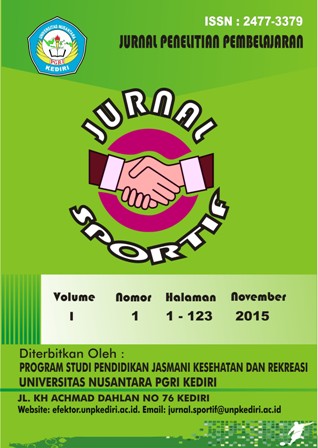Abstract
Tujuan dari penelitian ini yaitu untuk menganalisis tentang: (1) pengaruh pemberian three cone drill terhadap kelincahan (agility) dan kecepatan (speed); (2) pengaruh pemberian four cone drill terhadap kelincahan (agility) dan kecepatan (speed); (3) pengaruh pemberian five cone drill terhadap kelincahan (agility) dan kecepatan (speed); (4) manakah yang berpengaruh lebih besar antara latihan three cone drill, four cone drill, five cone drill dalam meningkatkan kelincahan (agility) dan kecepatan (speed). Sasaran penelitian ini adalah peserta SSB se-Kecamatan Pare kelompok umur 16-17 tahun dengan jumlah sampel sebanyak 45 peserta.
Jenis penelitian yang digunakan adalah kuantitatif dengan metode eksperimen. Rancangan penelitian ini menggunakan pre and post test design, dan analisis data menggunakan Anova. Proses pengambilan data dilakukan dengan menggunakan tes lari model Z untuk kelincahan dan lari 30 meter untuk kecepatan pada saat pretest dan posttest. Selanjutnya data hasil penelitian dianalisis dengan menggunakan bantuan SPSS seri 17.0.
Hasil penelitian menunjukkan: (1) Nilai Sig. sebesar 0,000 lebih kecil dari 0,05 (p<0,05). Dengan kata lain terdapat pengaruh yang signifikan latihan three cone drill terhadap peningkatan kelincahan (agility) dan kecepatan (speed); (2) Nilai Sig. sebesar 0,000 lebih kecil dari 0,05 (p<0,05). Dengan kata lain terdapat pengaruh yang signifikan four cone drill terhadap peningkatan kelincahan (agility) dan kecepatan (speed); (3) Nilai Sig. sebesar 0,000 lebih kecil dari 0,05 (p<0,05). Dengan kata lain terdapat pengaruh yang signifikan five cone drill terhadap peningkatan kelincahan (agility) dan kecepatan (speed).
Berdasarkan analisis diatas dapat disimpulkan bahwa terdapat pengaruh yang signifikan pada latihan three cone drill, four cone drill, five cone drill terhadap peningkatan kelincahan (Agility) dan kecepatan (Speed). Latihan five cone drill lebih optimal dalam meningkatkan kelincahan (agility) dan latihan three cone drill lebih optimal dalam meningkatkan kecepatan (speed).
References
Barnes, M. Incorporating Agility Into an Off Season Football Program. NSCA’s Performance Training Journal. Vol.5 no 4.
Hadisasmita dan Syarifuddin, A. 1996. Ilmu Kepelatihan Dasar.Jakarta: Depdikbud Dirjen Dikti Proyek Pendidikan Tenaga Akademik
Harsono. 1988. Coaching dan Aspek-aspek Psikologi dalam Coaching. Jakarta: Dirjen Dikti Proyek Pengembangan Lembaga Pendidikan Tenaga Kependidikan.
Harsono. 1993. Latihan Kondisi Fisik, Jakarta: Koi Pusat.
Harsono. 2001. Latihan Kondisi Fisik. Bandung: Proyek Pengembangan Lembaga Pendidikan Tenaga Kependidikan, Departemen Pendidikan dan Budaya.
Holmberg, P.H. 2009. “Agility Training for Experienced Athletes: A Dynamical Systems Approach”. Strength and Conditioning Journal. Vol. 31 No. 3 Oktober 2009. pp. 73 - 78.
http//www.humankinetics.com/excerpts/excerpts/three-cone-drills. Diakses tanggal 12 Desember 2013.
Lutan, R., Supandi., Giriwijoyo, S., Ichsan, M., Setiawan, I., Nadisah., Hidayat, I., Nurhasan. Dan Wiramihardja, K.K. 1998. Manusia dan Olahraga. Bandung: ITB dan FPOK/IKIP Bandung.
Kapidzic, A., Pojskic H., Mutatovic, M., Uzicanin, E., and Bilalic, A. 2011. Correlation of Tests for Evaluating Explosive Strength and agility of Football Player. Sport SPA. Vol 8. Issue 2. 29-34.
Maksum, A. 2012. Metodologi Penelitian dalam Olahraga. Surabaya: Unesa University Press.
Milanovic, Z. et al. 2011. “Difference in Agility Performance Between Futsal and Soccer”. Sport Science. Vol 4. No 2.pp. 55-59.
Nala, N. 1998. Prinsip Pelatihan Fisik Olahraga. Denpasar: Universitas Udayana.
Pebles, J. 2009. Agility Drill: Improve Your Foot Speed And Balance. CSCS
Reilly, T. 2005.Training Specificity for Soccer. International Journal of Applied Sports Sciences, Vol. 17, No. 2, 17-25.
Reilly, T. 2007. The Sience of Training Soccer: A Scientific Approach to Developing Strehth, Speed and Endurance. USA: Routledge.
Riyanto, Y. 2007. Metodologi Penelitian Pendidikan Kualitatif dan Kuantitatif. Surabaya: Unesa University Press.
Roesdiyanto dan Budiwanto, S. 2008. Dasar-dasar Kepelatihan Olahraga. Malang: Laboratorium Ilmu Keolahragaan, Jurusan Ilmu Keolahragaan, Universitas Negeri Malang.
Sandler, D. 2005. Sport Power Develop the Optimal, Combination of Size, Speed, Strength. America: Human Kinetics.
Sugiyono. 2010. Metode Penelitian Bisnis (Pendekatan Kuantitatif, Kualitatif dan R&D). Bandung: Alfabeta
Sporis, G., Jukic, I., Milanovic, L., And Vucetic, V. 2010. “Reliability and Factorial Validity of Agility Tests for Soccer Players”. Journal of Strength and Conditioning Research. Vol. 24 No. 3 March 2010. pp. 679–689.
Sporis, G., Milanovic, Z., Trajkovic., and Joksimovic, A. 2011. Correlation Between Speed, Agility and Quickness (SAQ) in Elite Young Soccer Players. Acta Kinesiologica. 5.2: 36-41.
Sriundy, I. 2010. Pengantar Evaluasi Pengajaran. Surabaya: Unesa University Press.
Sukadiyanto dan Muluk, D. 2011. Pengantar Teori dan Metodologi Melatih Fisik. Bandung: Lubuk Agung.
Widodo, A. 2007. “Pengembangan Rangkaian Tes Fisik untuk Pemain Sepakbola”. Disertasi Doktor Ilmu Keolahragaan, Universitas Negeri Surabaya.
Young, W. B., & Sheppard, J.M. 2006. Agility Literature Review: Classifications, Training and Testing. Journal of Sports Sciences. September 2006; 24(9): 919–932.
Authors who publish with this journal agree to the following terms:
- Copyright on any article is retained by the author(s).
- The author grants the journal, the right of first publication with the work simultaneously licensed under a Creative Commons Attribution License that allows others to share the work with an acknowledgment of the work’s authorship and initial publication in this journal.
- Authors are able to enter into separate, additional contractual arrangements for the non-exclusive distribution of the journal’s published version of the work (e.g., post it to an institutional repository or publish it in a book), with an acknowledgment of its initial publication in this journal.
- Authors are permitted and encouraged to post their work online (e.g., in institutional repositories or on their website) prior to and during the submission process, as it can lead to productive exchanges, as well as earlier and greater citation of published work.
- The article and any associated published material is distributed under the Creative Commons Attribution-ShareAlike 4.0 International License





